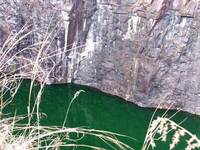- England
- Scotland
- France
- Holland
- Germany
- Italy
- Spain
- Portugal
- USA
- China
- Japan
- India
- Iran
- Advice
- Gardens
- England
- Scotland
- France
- Holland
- Germany
- Italy
- Spain
- Portugal
- USA
- China
- Japan
- India
- Iran
- Advice
- Garden Tours
Book: Landscape Planning and Environmental Impact Design: from EIA to EID
Chapter: Chapter 6 Mineral working, planning and design
Old mines can have new uses. For centuries it has been known that mining produces a range of harmful sideï¾effects - and that they can be ameliorated. The first European textbook on mines and quarries, written by Georgius Agricola in 1550, considered the case against mineral extraction and concluded: The strongest argument of the detractors is that the fields are devastated by mining operations, for which reason formerly Italians were warned by law that no one should dig the earth for metals and so injure their very fertile fields, their vineyards, and their olive groves... And when the woods and groves are felled, then are exterminated the beasts and birds, very many of which furnish a pleasant and agreeable food for man. Further, when the ores are washed, the water which has been used poisons the brooks and streams, and either destroys the fish or drives them away... Thus it is said, it is clear to all that there is greater detriment from mining than the value of the metals which the mining produces (Agricola 1912 edn. 8). Whilst mining continues, the environmental sideï¾effects are wholly undesirable. But when working has ceased, beneficial side effects arise. Agricola knew this: Moreover, as the miners dig almost exclusively in mountains otherwise unproductive, and in valleys invested in gloom, they do either slight damage to the fields or none at all. Lastly, where woods and glades are cut down, they may be sown with grain after they have been cleared from the roots of shrubs and trees. These new fields soon produce rich crops, so that they repair the losses which the inhabitants suffer from increased cost of timber (Agricola 1912 edn. 14). Agricola's book was translated, from Latin, by Hoover while he was president of America. There are three crucial points: Mineral operations cause great environmental harm. When finished, mining can leave land in a pitiful condition. Mining can create valuable new land characteristics. The Foreword to a 1975 book on Minerals and the environment, published by the Institution of Mining and Metallurgy, acknowledged, with some reluctance, that: Perhaps the increase in population has forced us to realise that there are now too few pleasant places for us to cover them up with slag heaps or destroy them with sulphur and arsenic; too few fish left in the streams for us to destroy them with toxic effluents; too little fresh air for us to mix it with smoke and dust. Our conscience will no longer allow us to do what our ancestors did without question; and if it did, there are laws to constrain us' (Jones 1975 x.). The name of the world's largest mining corporations stands as a monument to the old times [Fig 6.1]. RTZ, the Rio Tinto Zinc Mining Corporation takes its name from the 'tinted river' area of Spain. Copper was mined there by the Romans. This was considered preferable to despoiling the landscape of Italy but 'in more than a thousand years, the countryside round the Rio Tinto did not recover from the effect of the fumes from the ancient smelters. No vegetation grew and no birds sang amongst the abandoned pitï¾shafts' (West 1972: 14). A writer, in 1634, described Rio Tinto's 'terrorizing aspect, a simple glance at it causing apprehension and dismay to the casual and infrequent visitor' (West 1972: 14). Concern for the welfare of gloomy valleys and unproductive mountains is not such a new phenomenon. Yet the need for care is increasing. The richer a society becomes, the greater its per capita demand for aggregates and other minerals. They are used to make larger houses, longer roads, bigger universities, more airports and other features. Everyone involved with the planning and environmental aspects of the minerals industry should take note. Unless it adopts an EID approach, the industry's future will be as perilous as a neglected mine shaft. Even in poor countries, minds are no longer closed to environmental despoliation. In rich countries, opposition to mineral working must be expected to grow and grow. In the environs of great cities, it is already intense. To the east of London local deposits of chalk and gravel were used to make concrete. With these extractive industries now subject to severe environmental pressure, the materials are increasingly arriving by sea. Granite aggregates come from the West of Scotland. Cement comes from Southern Europe. To save Europe's mineral industries from extinction, operators must learn: -to minimise environmental harm while working proceeds -to create post-quarrying landscapes which are self-evidently as good as the pre-quarrying landscapes -to achieve these goals by imaginative planning and design, rather than exorbitant expenditure It can be done. It must be done. It will be done, someday.
